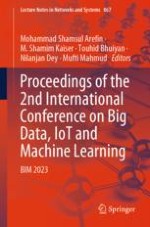2024 | OriginalPaper | Buchkapitel
An Ensemble Machine Learning Approach to Classify Parkinson’s Disease from Voice Signal
verfasst von : Md. Mahedi Hassan, Md. Fazle Rabbi, Mahmudul Hasan, Bhagyobandhu Roy
Erschienen in: Proceedings of the 2nd International Conference on Big Data, IoT and Machine Learning
Verlag: Springer Nature Singapore
Aktivieren Sie unsere intelligente Suche, um passende Fachinhalte oder Patente zu finden.
Wählen Sie Textabschnitte aus um mit Künstlicher Intelligenz passenden Patente zu finden. powered by
Markieren Sie Textabschnitte, um KI-gestützt weitere passende Inhalte zu finden. powered by
